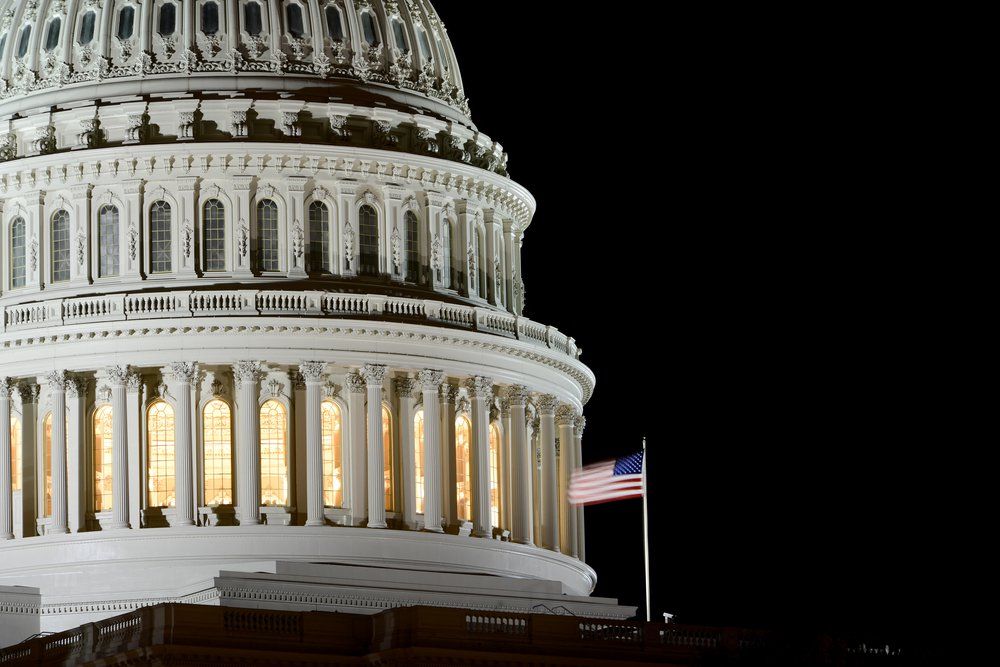Article
Washington Beat
Bureaucracy, Medicare, Lobbying, Congress, Marketplace
Washington Beat
By Michael Pretzer, Washington Editor
Bureaucracy: If HCFA gives you nightmares, Billy Tauzin wants to know
Rep. Billy Tauzin (R-LA), chairman of the Energy and Commerce Committee, is on a mission. He's determined to make the Health Care Financing Administration more "patient-friendly and physician-friendly," says his spokesman.
Right now, Tauzin is in fact-finding mode. He has toured HCFA offices and begun a series of hearings. He's surveying Medicare beneficiaries and physicians. Have you gotten his questionnaire yet? Eventually, he'll draft legislation to improve HCFA's program management. But not until he's gathered lots of data. "We're not putting the cart before the horse," promises the spokesman.
At a recent AMA conference, Tauzin made his review of HCFA sound like an inquisition. He vowed to put the agency "on trial," comparing his effort to recent congressional reform of another beloved federal agency, the Internal Revenue Service.
At the conference, Tauzin issued a call to physicians: Send me your complaints about HCFA; tell me your horror stories. The AMA has been happy to oblige. One such story is that of John Hoyt, who has been practicing critical care medicine for 25 years in Pittsburgh. Hoyt, a member of a Medicare carrier advisory committee, is pretty well versed in the program's treatment coverage. So imagine his surprise when, in 1998, his group, Pittsburgh Critical Care, was ordered to return almost $340,000 that it had been paid for alleged medically unnecessary services. The sum had been extrapolated from an audit of 29 patient records.
Hoyt appealed, then had to wait 24 months for a review of the case. Another year has gone by, and still no final decision. In the meantime, an additional 299 of Pittsburgh Critical Care's records have been audited.
Medicare: The good news isn't good enough
According to this winter's report from HHS's Office of Inspector General, fee-for-service Medicare wasted less money making erroneous payments in 2000 than in 1999. The OIG estimates last year's total to be $11.9 billion, about 6.8 percent of the entire FFS payment. In 1999, improper payments totaled $13.5 billion, about 8 percent.
All in all, the OIG seemed pleased. "HCFA has demonstrated continued vigilance in monitoring the error rate and developing appropriate corrective action plans," it stated in its report. "Such efforts have contributed to the large reduction in the improper payment rate."
Some of HCFA's usual critics in Congress agree with the OIG. "I say we should praise HCFA for its efforts," says Rep. Pete Stark (D-CA).
But others see the $1.6 billion decrease as woefully inadequate. "This is an old story," says Sen. Chuck Grassley (R-IA), chairman of the Finance Committee. "Year after year, the government wastes billions of dollars on improper Medicare payments. Some of the waste probably goes to innocent billing mistakes. Some of it undoubtedly goes to fraud. With all its resources, the government should be able to stop this milking of the treasury."
Grassley promises action. For starters, he says, HHS Secretary Tommy Thompson will cut waste and "squeeze value from every tax dollar." And Grassley's working with the OIG "to stop improper payments to treat prison inmates, the deceased, the deported, and others who don't deserve a legitimate claim on Medicare dollars."
Last year, an OIG audit found that Medicare paid $20.6 million in 1997 for the care of dead people. This year, the OIG plans to look at payments made to the incarcerated and the deported.
In another report, the Medicare trustees announced that funds are available to pay Part A expenses until 2029, four years longer than the trustees projected last year. Good news if you're a believer in their forecasts.
Unfortunately, the trustees also reported that once the baby boomers invade Medicare, the gap between expenditures and revenue will grow faster than previously anticipated. Today, according to the trustees, about four workers generate tax revenue for each Medicare beneficiary. In 2075, there will be only two per beneficiary.
In addition, spending for Part B services is increasing uncomfortably fastby 10 percent from 1999 to 2000. The rapid uptick is due to accounting changes, the cost of new screening benefits, and "an above-average increase in physician fees," say the trustees.
Last year, about 5 percent of federal income tax revenue was allocated to cover Part B expenditures. All things being equal, the percentage will climb to 22 percent in 2070, according to the trustees.
Politicians of differing persuasions have been using the trustees' forecast to support their long-held views on Medicare reform. Those who want Congress to legislate a prescription drug benefit for seniors immediately but go slowly on substantial change say the report shows we've plenty of time before real problems arise. Those who want to pass the drug benefit and systemwide reform this year say the report proves that to postpone is dangerous. "We must take this opportunity now, because every year of delay will narrow our options and make the job more difficult," concludes HHS Secretary Thompson.
Improper payments to doctors
Lobbying: Doctors oppose suing HMOs, says a managed care trade group
In the battle over a patient protection act, the American Association of Health Plans recently pulled a fast one. It released a survey showing that doctors agree with the association on the most contentious protection: medical liability. AAHP claims that doctors believe patients shouldn't be allowed to sue an HMO.
Really?
Ayres McHenry & Associates of Roswell, GA, which was commissioned by AAHP to do the survey, interviewed 400 physicians from across the country. Half were primary care doctors, half were specialists. About a third were members of the AMA.
Seventy-five percent of the physicians said they'd prefer that patients have access to an independent appeals process, while only 17 percent want patients to have the right to sue a health plan. For good measure, Ayres McHenry elicited from doctors a couple of other antiliability opinions. Many said they'd rather see Congress pass a patients' rights act without a liability provision than no bill at all. They believe a liability provision would benefit trial lawyers far more than patients.
"For the past four years, we've heard the constant refrain from some inside-the-beltway spinmeisters that expanded liability represents the best course for improving the health care system," crowed Karen Ignagni, AAHP's president and CEO, when the study was released. "It's time to put this myth to rest by listening to what those on the front linesAmerican physiciansare saying."
The AMA, obviously one of the "spinmeisters" Ignagni had in mind, is unaware that "American physicians" are saying any such thing about a patients' rights act. It's been pushing, pushing, pushing Congress to pass one, and insisting that the act must include the right to hold managed care liable for treatment-related decisions. "When health plans play doctor and harm or kill patients, they should be answerable to the same state judicial review that holds real doctors accountable," says Thomas Reardon, the AMA's immediate past president.
In February, the AMA endorsed the patient protection legislation sponsored by Sens. John McCain (R-AZ) and Edward M. Kennedy (D-MA) and Reps. Greg Ganske (R-IA) and John D. Dingell (D-MI). The bill would give patients the right to sue an HMO in federal court over administrative decisions that involve death or injury, and in state court over medical decisions. "The legislation puts patients over big HMO profits," proclaims D. Ted Lewers, chair of the AMA board.
Not surprisingly, the AMA has denounced AAHP's poll as self-serving. "The questions were designed to elicit a specific response," says Reardon. "I give the survey no credence."
Reardon suggests that AAHP's ploy may be an act of desperation. "In Washington there's broad bipartisan support for a patients' bill of rights, and 80 to 90 percent of Americans want to have the right to sue their managed care plans," he says. "A bill will be passed this year."
For what it's worth, AAHP's survey also found that:
- 92 percent of doctors think the threat of a lawsuit increases the practice of defensive medicine.
- 78 percent think the threat of a lawsuit does nothing to improve a doctor's care.
- 62 percent think the current liability system hurts the physician-patient relationship.
- 61 percent think the liability system is unfair.
- 57 percent think the liability system makes doctors more reluctant to report medical errors.
- 45 percent voted for George W. Bush; 22 percent cast a ballot for Al Gore.
Marketplace: What patients don't know about the quality of their health care
"Consumers want information about their doctors. We're going to fill that need," promises Margaret E. O'Kane, president of the Washington-based National Committee for Quality Assurance.
NCQA, which evaluates managed care plans primarily for the benefit of corporations and other employers, recently announced that it would spend 21 months developing "measures of physician quality based on input from consumers, purchasers, and health care organizations."
Today, there's scant information to help individuals assess their physicians, according to NCQA. What's more, no one really seems to understand what data individuals want or need.
If the research of another Washington-based organization is accurate, NCQA has a formidable task ahead of it. When the Center for Studying Health System Change interviewed consumers about four features of their health plan, only 30 percent of respondents correctly identified all four.
- 58 percent knew that their plan required a referral for specialty care.
- 69 percent knew that their plan paid a portion of the cost of out-of-network care.
- 73 percent knew that their plan required the selection of a primary care physician.
- 80 percent knew that their plan had a provider network.
"Early efforts to educate consumers about health plans and quality have not been very effective," concludes the center.
NCQA, take note.
Congress: Can the tax man deliver health care to the uninsured?
More and more, it looks like Congress is going to take the easy way out.
If it does anything this year to decrease the number of Americans without health insurance, it will pass a tax credit. Several bills have been drafted and other proposals are being advanced by the likes of the AMA, the American College of Physicians-American Society of Internal Medicine, and the Health Insurance Association of America. There are tax credits to encourage employers to offer insurance. There are tax credits to individuals to help them afford insurance. There are refundable tax credits for poor people so they can get money for insurance.
The tax credit is about as noncontroversial as anything gets in Washington. What sane person would stand up and say Americans should pay more income tax, even if it means going without health care? What opposition there is to the idea comes from those who think the tax credit might not work.
One of the tax-credit bills under consideration, the Relief, Equity, Access, and Coverage for Health (REACH) Act, would provide a credit of up to $400 for an individual and up to $1,000 for a family to buy employer-provided health insurance. Last year, however, the average annual cost for individual coverage through an employer was $2,424, according to the Kaiser Family Foundation. (An HMO plan cost an average of $2,172, a fee-for-service plan $2,856.) Family coverage averaged $6,348. (An HMO cost an average of $5,844; fee-for-service, $7,296.) Kaiser's figures combine employee and employer costs, so the price to an individual worker would be lower, depending on his employer's generosity.
It's obvious that REACH's tax credit won't cover the cost of insurance. But perhaps it's sufficient to persuade some of the nearly 43 million uninsured to buy coverage.
Michael Pretzer. Washington Beat. Medical Economics 2001;10:21.





